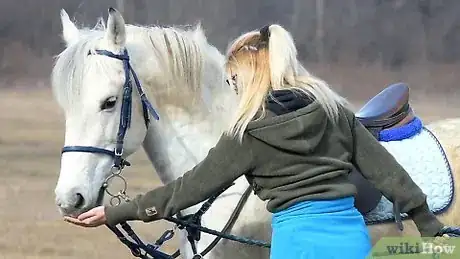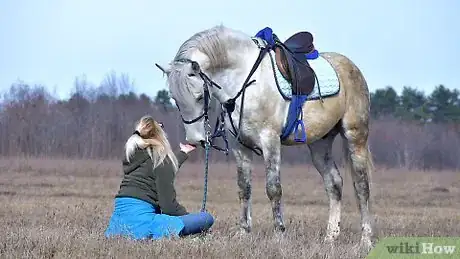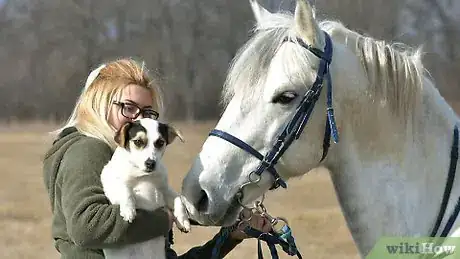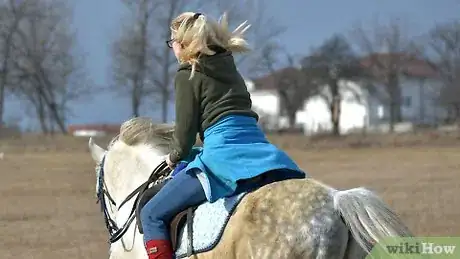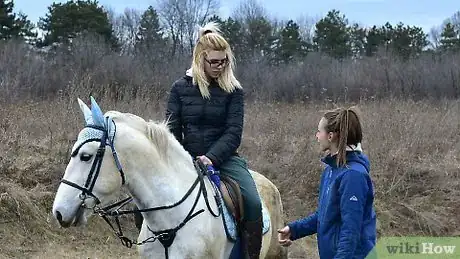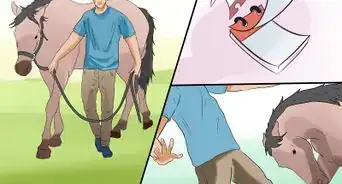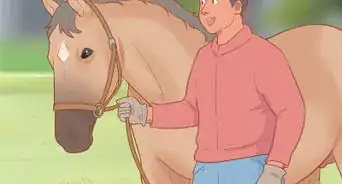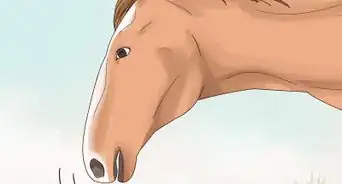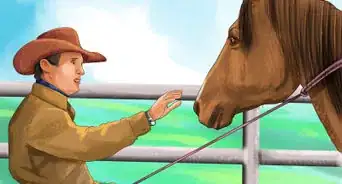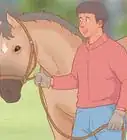This article was co-authored by Alana Silverman. Alana Silverman is a Certified EAGALA (Equine Assisted Growth and Learning Association) Equine Specialist and the Assistant Manager of Paddock Riding Club, a 200-horse premier equestrian facility based in Los Angeles, California. Alana has over 25 years of experience caring for and riding horses and specializes in English riding and riding instruction. She has a BA in Psychology from the University of Arizona.
There are 8 references cited in this article, which can be found at the bottom of the page.
wikiHow marks an article as reader-approved once it receives enough positive feedback. This article received 12 testimonials and 87% of readers who voted found it helpful, earning it our reader-approved status.
This article has been viewed 214,203 times.
The key to any relationship is trust, and that is particularly important when it comes to horses. Trust is crucial, as a horse who doesn't trust his owner may end up intentionally or inadvertently hurting that person. Like any other relationship, trust comes from a lot of hard work and time spent together.[1] Learning how to earn your horse's trust can help you ride with confidence and build a lasting relationship with your animal.
Steps
Building a Relationship With Your Horse
-
1Approach your horse correctly. If your horse is anxious as you approach him for training, you may be approaching him wrong. Some horses are fearful of humans (or any animals) that approach head-on.
- Try approaching from the side and avoid direct eye contact.
- As you get close to your horse, hold your hand out to allow the horse to sniff you. If the horse is still afraid, try bending at the waist while you hold out your hand and avert your gaze.
-
2Spend time with your horse. Other than grooming and riding your horse, how much time do you really spend together? You can learn a lot about a horse's personality and behavioral tendencies by observing your horse for any period of time. Try sitting nearby while your horse roams or interacts with other horses, and let him get comfortable with your presence. You may also get a pretty good idea of why your horse behaves the way he does by watching him and spending time with him.[2]
- Try to spend some time with your horse every day. Even if you only have 10 or 20 minutes, you can spend that time grooming your horse or squeezing in a short warm-up ride.[3]
EXPERT TIPAlana Silverman is a Certified EAGALA (Equine Assisted Growth and Learning Association) Equine Specialist and the Assistant Manager of Paddock Riding Club, a 200-horse premier equestrian facility based in Los Angeles, California. Alana has over 25 years of experience caring for and riding horses and specializes in English riding and riding instruction. She has a BA in Psychology from the University of Arizona.Certified EAGALA Equine Specialist
 Alana Silverman
Alana Silverman
Certified EAGALA Equine SpecialistOur Expert Agrees: Do activities and play games with your horse on the ground or in a small arena or pen. The more time you spend with your horse, the more trust you'll be able to develop.
Advertisement -
3Talk to your horse. Some people might feel awkward talking to an animal that can't talk back. But some horse owners find that talking to a horse can help gain the horse's trust and get him used to being around humans. Try speaking to your horse using a calm yet assertive tone. Your horse will learn that he can feel comfortable in your presence and that you are a reliable leader.[4]
-
4Walk together. If your horse hasn't earned your trust yet, riding him for prolonged periods may be difficult or even dangerous. But that doesn't mean you can't get out of the stable with your horse. Try taking your horse for a long walk in the woods, leading him by the reigns as you would lead a dog on a leash. This can help your horse learn to grow comfortable traveling with you and being guided by your lead.[5]
Using Training to Build Trust
-
1Use relaxation techniques to train your horse. Part of training your horse and building trust must include learning how to calm your horse. It's important not to rush this part, as forcefully laying your hands on a horse that doesn't trust you could result in further mistrust and even injury. Once your horse gets used to your touch, you can use a variety of relaxation techniques to help facilitate training if your horse is being stubborn or fearful.
- Stand next to your horse's head, facing the same direction as he is. Hold the lead rope in your hand and slowly bend down at the waist with your head down. Gently guide the horse's head down with you. This should pull your horse out of his alert, guarded pose, and over time he will see that he can safely let his guard down around you.
- Stroke or scratch your horse, but don't pat him. Patting is not something that horses do to each other in the wild. Stroking or scratching mimics the way a horse might rub against another horse in the wild, and it's the best way to soothe an anxious horse and get him used to your touch.
- Use an index finger to gently stroke the groove that runs down the top of your horse's muzzle. Stroke gently and run your finger down the entire length of the muzzle. This can be incredibly relaxing in some horses, and will help desensitize your horse to your touch.
- Hold your horse's muzzle with one hand and gently slide one finger from your other hand into the back corner of your horse's mouth. Horses shouldn't have teeth in that part of the mouth, but it's still important to proceed cautiously. Don't force this exercise if your horse still isn't comfortable being touched by you. Once your finger is in, gently and very briefly stroke your horse's tongue. This teaches the horse to submit to you, and over time will earn his trust.
-
2Train in increments. This might sound like common sense, but it's easy to forget that expecting too much too soon from an animal can be stressful and confusing. Training is a great way to build trust with your horse, but it should be done in a scaffolded approach. Start with small, easy to accomplish tasks and work your way up to more challenging training lessons.
- Start with what your horse already knows. Then add easy challenges that you know he will be able to accomplish without too much effort.
- If your horse isn't ready to jump over a new obstacle, that's okay. Get him comfortable standing near the obstacle and smelling/looking at it, so that, over time, he'll be comfortable and mentally prepared to jump over the obstacle.
- Don't rush your horse. If he's still not comfortable jumping over obstacles, forcing him to jump will only make him more distrustful of you, and could cause harm to both you and your horse. Let your horse investigate the obstacle as much as he needs to before he's ready to jump over it, and be sure he's comfortable being around the obstacle before you attempt to jump it.
-
3Reward successful training. Any time you train your horse to accomplish a new task and he attempts the challenge, give him a reward, even if he doesn't fully accomplish the task. The key is to teach your horse that it's advantageous to try for you. Eventually, with enough reassurance and reward, your horse will want to try for you, not just for a treat.
- Choose healthy treats as rewards. Vegetables like apples, carrots, and celery make excellent treats for horses if cut into small enough pieces.[6]
- Do not give your horse vegetables that tend to cause gas like cabbage or Brussels sprouts. Never give your horse any plants from the nightshade family, including onions, potatoes, tomatoes, eggplant, and peppers.[7]
- Always give treats in moderation. Giving too many treats or giving treats too often can also create problems like constant expectations of food, which can lead to nipping. For this reason, it's important to set some kind of boundaries when it comes to how you reward your horse's behavior.[8] Generally speaking, one or two pieces of horse-appropriate vegetables should suffice as a treat or reward.[9]
- Be cautious with hand-feeding your horse treats. If your horse doesn't trust you yet, he might try to snatch treats as quickly as possible, which could result in your hand getting bit. Instead, offer treats in a bucket or feeding trough.[10]
Building Your Horse's Confidence
-
1Confront his fears. If your horse has certain anxieties - like crossing water, for example - you'll need to help your horse confront those fears. But that doesn't mean you should force your horse to run recklessly into whatever he's afraid of. Forcing a horse to confront a fear too quickly could frighten the horse and may cause injury to you, but over time he should confront those fears. The best part about helping your horse confront his fears is that he'll remember your role in the process, and he should come to respect and trust you.[11]
- Build your horse's confidence by leading him to whatever he's afraid of - say a creek that runs across your property.
- Use relaxation techniques to calm your horse, then lead him slowly toward the water. Let him watch the water, sniff the shore, and once he feels comfortable stepping into the water, let him stand in the water for a few moments to understand that it's not a threat.
-
2Recognize your own fears. If your horse hasn't learned to trust you, you might be part of the problem. Horses can sense when a rider is tense or anxious, and any hesitation on your part could cause your horse to lose his trust and confidence in you. Try confronting your riding fears with your horse, using relaxation techniques and a soothing but confident voice. As you get more comfortable riding your horse through scenarios that previously made you nervous, your horse should get more comfortable confronting those scenarios with you.[12]
-
3Consider lessons for your horse. If you simply can't earn your horse's trust, you might need to hire a professional. Professional trainers can work with you and your horse to learn why your horse may be reluctant to trust you, and can teach you how to overcome those obstacles.[13]
- Bucking, bolting, and rearing up are all examples of bad horse behavior that need to be corrected. These actions are generally caused by your horse not trusting or respecting you, and can cause serious harm to you or other riders.[14] If your horse engages in any of these behaviors, contact a qualified horse trainer before any further attempts at riding your horse.
- Look for a trainer or other qualified expert through a professional organization, like the American Quarter Horse Association. Search online for a trainer near you.
Expert Q&A
-
QuestionHow do you tell if your horse likes you?
 Alana SilvermanAlana Silverman is a Certified EAGALA (Equine Assisted Growth and Learning Association) Equine Specialist and the Assistant Manager of Paddock Riding Club, a 200-horse premier equestrian facility based in Los Angeles, California. Alana has over 25 years of experience caring for and riding horses and specializes in English riding and riding instruction. She has a BA in Psychology from the University of Arizona.
Alana SilvermanAlana Silverman is a Certified EAGALA (Equine Assisted Growth and Learning Association) Equine Specialist and the Assistant Manager of Paddock Riding Club, a 200-horse premier equestrian facility based in Los Angeles, California. Alana has over 25 years of experience caring for and riding horses and specializes in English riding and riding instruction. She has a BA in Psychology from the University of Arizona.
Certified EAGALA Equine Specialist Most often, if a horse moves towards you, it's curious, but if it's moving away from you, it doesn't want to be close to you. So for horses that have their freedom of movement, just their location is a good indication of whether they're feeling comfortable or not.
Most often, if a horse moves towards you, it's curious, but if it's moving away from you, it doesn't want to be close to you. So for horses that have their freedom of movement, just their location is a good indication of whether they're feeling comfortable or not. -
QuestionHow will my horse react when it starts loving me, too?
 Community AnswerHe might follow you around and will want to be with a lot, welcoming you every time you go to him. He might neigh or make a welcoming noise when he sees you.
Community AnswerHe might follow you around and will want to be with a lot, welcoming you every time you go to him. He might neigh or make a welcoming noise when he sees you. -
QuestionHow do I make my horse realize that I am the leader?
 Community AnswerIf he is pushing you with his head or shoulder, this is a sign that he doesn't think you are a leader. The dominant horse stands in place, while a submissive moves out of the way. Try pushing gently on his head or shoulders to assert your dominance.
Community AnswerIf he is pushing you with his head or shoulder, this is a sign that he doesn't think you are a leader. The dominant horse stands in place, while a submissive moves out of the way. Try pushing gently on his head or shoulders to assert your dominance.
References
- ↑ http://www.womenandhorses.com/newsletter-august2005.html
- ↑ http://equusmagazine.com/article/common-language-27149
- ↑ http://www.stwnewspress.com/community/local_columnists/happy-trails-spending-intentional-time-with-your-horse-leads-to/article_9a59353e-5421-11e5-893e-03384d01bdad.html
- ↑ http://www.horsechannel.com/horse-community/horse-human-bond.aspx
- ↑ http://www.womenandhorses.com/newsletter-august2005.html
- ↑ https://ker.com/equinews/feeding-treats-horses/
- ↑ https://ker.com/equinews/feeding-treats-horses/
- ↑ http://www.horsechannel.com/horse-community/horse-human-bond.aspx
- ↑ https://ker.com/equinews/feeding-treats-horses/
- ↑ https://ker.com/equinews/feeding-treats-horses/
- ↑ http://equusmagazine.com/article/build-trustworthy-trail-horse-10655
- ↑ http://www.writingofriding.com/training/trust-building-as-a-training-method/
- ↑ http://www.writingofriding.com/training/trust-building-as-a-training-method/
- ↑ http://www.horsechannel.com/horse-training/handling-bad-behavior.aspx
About This Article
To get your horse to trust you, try approaching it from the side. Avoid direct eye contact, and as you get close, hold out your hand so the horse can sniff you. If the horse is still afraid, try bending at the waist while you hold out your hand. Try to spend time with your horse every day, even if it’s only 10-20 minutes. This way, the horse can get used to your presence, and you can learn about its personality. Talk to your horse in a calm, assertive voice, and take it for walks, leading it by the reins, to help build a relationship. For tips from our veterinary reviewer on building trust through training, read on!
